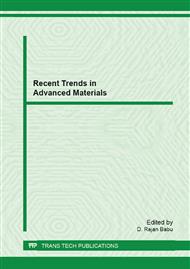[1]
S. H. D. Hulleman, F. H. P. Janssen and H. Feii , The role of water during plasticization of native Starches, Polymer, 39 (1997) 2043-2048
[2]
J. J.G. Van Soest, S.H.D. Hulleman, D. de Wit, J.F.G. Vliegenthart, Crystallinity in starch bioplastics, Industrial Crops and Products, 5 (1996) 11-22
[3]
M. Aloui, J. Soulestin, M.-F. Lacrampe, P. Krawczak, D. Rousseaux,n J. Marchand-Brynaert, J. Devaux, N. Quiévy, M. Sclavons, A new elaboration concept of polypropylene/unmodified Montmorillonite nanocomposites by reactive extrusion based on direct injection of polypropylene aqueous suspensions, Polymers Engineering and Science, 49 (2009) 2276-2285
DOI: 10.1002/pen.21474
Google Scholar
[4]
K. Prashantha, J. Soulestin, M.F. Lacrampe, P. Krawczak, G. Dupin, M. Claes, Masterbatch-based multi-walled carbon nanotube filled polypropylene nanocomposites: Assessment of rheological and mechanical properties. Composites Science and Technology, 69 (2009) 1756-1763
[5]
K. Prashantha, H. Schmitt, M.F. Lacrampe, P. Krawczak, Mechanical behavior and essential work of fracture of halloysite nanotubes filled poyamide 6 nanocomposites, Composite Science and Technology, 71 (2011) 1859-1866
[6]
K. Prashantha, M.F. Lacrampe, P. Krawczak, Processing and characterization of halloysite nanotubes filled polypropylene nanocomposites based on a masterbatch route: Effect of halloysites treatment on structural and mechanical properties, Express Polymer Letters, 5 (2011) 295-307
[7]
M. Du, B. Guo, D. Jia, Newly emerging applications of halloysite nanotubes: a review, Polymer International, 59 (2010) 574–582
[8]
W.Y. Zhou, B. Guo, M. Liu, R. Liao, A. Bakr, D. Jia, Poly(vinyl alcohol)/halloysite nanotubes bionanocomposite films: Properties ans in vitro osteoblasts and fibroblasts response, Journal of Biomedical Materials Research Part A, 93A (2009) 1574-1587
[9]
Pi. M. Forssella, J. M. Mikkilti , G. K. Moates, R. Parker, Phase and glass transition behaviour, of concentrated barley starch-glycerol-water mixtures, a model for thermoplastic starch, Carbohydrate Polymers, 34 (1997) 275-282
[10]
H.B. Lu, S. Nutt, Restricted relaxation in polymer nanocomposites near the glass transition, Macromolecules, 36 (2003) 4010-4016
[11]
P.Maija, P.Sami, S.Mika, T.P. Tuula, Influence of carbon nanotube–polymeric compatibilizer masterbatches on morphological, thermal, mechanical, and tribological properties of polyethylene.Compo Sci and Tech 71 (2011) 1353-1360
[12]
B.X. Yang, J.H. Shi, K.P. Pramoda, S. Hong Goh, Enhancement of stiffness, strength, ductility and toughness of poly(ethylene oxide ) using phenoxy grafted multi walled carbon nanotubes, Nanotechnology, 18 (2007) 12 art. N°125606
Google Scholar


